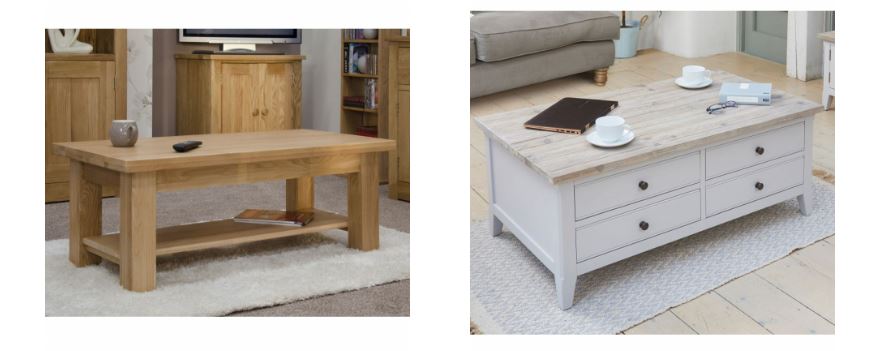An oak coffee table, remarkably sturdy and incredibly charming, embodies the essence of a living space in the same way that a signature scent embodies a memory. Solid oak has gained popularity among homeowners in recent years due to its ability to age gracefully and provide a room with a sense of effortless elegance. Oak tables have significantly increased the coziness and warmth of open-plan homes by incorporating exquisitely real wood grains and natural tones.
Furniture manufacturers like Oak Furniture Land have transformed the ordinary oak coffee table into an art form by utilizing handcraft techniques, combining soul-stirring craftsmanship with useful design. These companies have drastically lessened their environmental effect while providing tables that are remarkably elegant and sustainably sourced thanks to strategic alliances with sustainable forests.

The oak coffee table has transformed from a simple piece of furniture to a sought-after focal point in the last ten years, thanks to its noticeably better building methods and especially creative designs. Compact oak nesting tables are a very flexible option for medium-sized homes, where adaptable furniture is crucial. They can easily grow and shrink to accommodate social needs.
| Attribute | Details |
|---|---|
| Topic | Oak Coffee Table |
| Focus | Furniture craftsmanship, sustainability, home design |
| Key Materials | Solid oak, reclaimed oak, rustic and contemporary finishes |
| Leading Brands | Oak Furniture Land, Only Oak Furniture, Made with Oak |
| Celebrity Associations | Reese Witherspoon, Ellen DeGeneres |
| Industry Shift | Rise of eco-conscious and timeless home pieces |
| Key Selling Points | Durability, elegance, sustainability |
| Reference Source | Oak Furniture Land |
The oak coffee table proved to be incredibly resilient to daily wear during the pandemic, when distant life drastically altered interiors. It evolved into more than just a table; it became a reliable partner for laptops, board games, and warm coffee mornings. It embodied a level of durability that was rarely found in lighter, factory-made alternatives.
Brands like Home Barn and Still and Bloom created tables that were both surfaces and stories by using repurposed materials; every scratch added a layer to the table’s changing history, and every knot and grain spoke of decades past. Coffee tables have been miraculously transformed into living relics, treasured objects that become more exquisite with time, thanks to their careful design.
Oak coffee tables provide an incredibly useful balance in the context of contemporary design, where customization and narrative-driven areas are paramount. Their natural textures and muted hues go surprisingly well with bold interior design schemes, effortlessly balancing everything from industrial iron light fixtures to blush velvet couches.
Celebrities like Ellen DeGeneres, a passionate collector of rustic-modern interior design, have contributed to the rise in popularity of the trend in recent years of combining traditional oak furniture with cutting-edge décor to create rooms that feel carefully chosen rather than staged. As a result of these instances, oak tables have lost their outdated associations and are now remarkably modern and fresh.
Brands have greatly increased the usefulness of oak coffee tables by incorporating clever storage features like lift-up tops and concealed drawers. Today’s homeowners can transform the classic coffee table into a dynamic focal point for living rooms while also showcasing a sleek aesthetic and hiding away the inevitable clutter of modern life.
Oak has consistently been used as a symbol of subtle luxury at design expos from Paris to New York. Mass-produced veneer furniture just cannot match the tactile pleasure of running a hand over solid oak, both in terms of its natural texture and its pleasing weight.
Oak coffee tables actively set the mood for the energy of a space by being placed strategically throughout the interior. The oak table becomes a grounding element, subtly enhancing the interplay of light, texture, and human interaction, whether it is placed in the middle of a blown glass chandelier or next to a sun-drenched window with a sofa draped in linen.
Slim-profile oak tables with hairpin legs offer style without compromising valuable floor space, making them surprisingly affordable for smaller apartments. On the other hand, expansive celebrity estates like Reese Witherspoon’s frequently feature large rustic oak slabs that instantly convey a sense of permanence and earthy grandeur.
Oak coffee tables are anticipated to be at the forefront of “slow living” design in the upcoming years, when carefully selected, incredibly personal items take the place of decor that follows trends. Consumers are shifting away from throwaway furniture and toward more enduring pieces that feel like they belong in the changing stages of life.
Homeowners can make a decision that goes beyond aesthetics by promoting artisan manufacturers and companies that use oak that is sourced ethically. They are making investments in future craftsmanship, forests, and a design culture that prioritizes honesty over expediency. This shift in consumer consciousness is not only incredibly successful, but it is also sincerely optimistic.
Oak coffee tables have experienced a renaissance since the introduction of significant sustainability initiatives throughout the furniture industry, providing an especially advantageous option for environmentally conscious consumers. Oak represents durability and authenticity in contrast to engineered wood, which frequently involves chemical processes and has short lifespans.
An oak coffee table continues to be the focal point of the living room for those looking to design small, private spaces that subtly convey strength and beauty. By selecting one, you are selecting permanence in a world that is frequently characterized by the transient; you are selecting something deeper than wood and nails.
